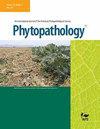求助PDF
{"title":"整合元件多次捕获相毒素生物合成基因簇,多次入侵丁香假单胞菌。","authors":"Luiz Orlando de Oliveira, Hugo Vianna Silva Rody, Selene Aguilera, Jesús Murillo","doi":"10.1094/PHYTO-01-25-0017-R","DOIUrl":null,"url":null,"abstract":"<p><p>Phaseolotoxin is a virulence factor of <i>Pseudomonas amygdali</i> pv. <i>phaseolicola</i> (Pph) and <i>P. syringae</i> pv. <i>actinidiae</i> (Psa). Herein, we explore the evolutionary history of a genomic island (Tox island) composed of an integrative element (GInt) carrying the 23-gene cluster (Pht cluster) for biosynthesis of phaseolotoxin and toxin resistance. Our analyses indicate that the Pht cluster has been acquired, either naked or associated with a GInt, on seven independent occasions by four phylogroups of the <i>P. syringae</i> complex (Pph, Psa, <i>P. caricapapayae</i>, and <i>P. syringae</i> pv. <i>syringae</i>) and the phylogenetically distant rhizobacterium <i>Pseudomonas</i> sp. JAI115. The Pht cluster was independently captured by three distinct GInt elements, suggesting specific mechanisms for gene capture. Once acquired, the Tox island tends to be stably maintained, evolving with the genome. The likely evolutionary trajectory of the Tox island within Pph and Psa involved (i) acquisition by Pph; (ii) transfer of the Tox island from Pph to Psa biovar 1; (iii) independent acquisition from unknown sources of a different version of the Tox island by Psa biovar 1, generating a second toxigenic lineage; (iv) independent acquisition from unknown sources of a third version of the Tox island by Psa biovar 6; and (v) replacement of the Tox island in Pph by a distantly related GInt, generating nontoxigenic isolates. These findings underscore the potential role of phaseolotoxin in bacterial fitness and contribute to our understanding of the evolutionary dynamics of mobile genetic elements and virulence evolution in bacterial plant pathogens. [Formula: see text] Copyright © 2025 The Author(s). This is an open access article distributed under the CC BY-NC-ND 4.0 International license.</p>","PeriodicalId":20410,"journal":{"name":"Phytopathology","volume":" ","pages":"1086-1096"},"PeriodicalIF":3.1000,"publicationDate":"2025-09-01","publicationTypes":"Journal Article","fieldsOfStudy":null,"isOpenAccess":false,"openAccessPdf":"","citationCount":"0","resultStr":"{\"title\":\"Integrative Elements Repeatedly Captured the Phaseolotoxin Biosynthesis Gene Cluster and Invaded <i>Pseudomonas syringae</i> Multiple Times.\",\"authors\":\"Luiz Orlando de Oliveira, Hugo Vianna Silva Rody, Selene Aguilera, Jesús Murillo\",\"doi\":\"10.1094/PHYTO-01-25-0017-R\",\"DOIUrl\":null,\"url\":null,\"abstract\":\"<p><p>Phaseolotoxin is a virulence factor of <i>Pseudomonas amygdali</i> pv. <i>phaseolicola</i> (Pph) and <i>P. syringae</i> pv. <i>actinidiae</i> (Psa). Herein, we explore the evolutionary history of a genomic island (Tox island) composed of an integrative element (GInt) carrying the 23-gene cluster (Pht cluster) for biosynthesis of phaseolotoxin and toxin resistance. Our analyses indicate that the Pht cluster has been acquired, either naked or associated with a GInt, on seven independent occasions by four phylogroups of the <i>P. syringae</i> complex (Pph, Psa, <i>P. caricapapayae</i>, and <i>P. syringae</i> pv. <i>syringae</i>) and the phylogenetically distant rhizobacterium <i>Pseudomonas</i> sp. JAI115. The Pht cluster was independently captured by three distinct GInt elements, suggesting specific mechanisms for gene capture. Once acquired, the Tox island tends to be stably maintained, evolving with the genome. The likely evolutionary trajectory of the Tox island within Pph and Psa involved (i) acquisition by Pph; (ii) transfer of the Tox island from Pph to Psa biovar 1; (iii) independent acquisition from unknown sources of a different version of the Tox island by Psa biovar 1, generating a second toxigenic lineage; (iv) independent acquisition from unknown sources of a third version of the Tox island by Psa biovar 6; and (v) replacement of the Tox island in Pph by a distantly related GInt, generating nontoxigenic isolates. These findings underscore the potential role of phaseolotoxin in bacterial fitness and contribute to our understanding of the evolutionary dynamics of mobile genetic elements and virulence evolution in bacterial plant pathogens. [Formula: see text] Copyright © 2025 The Author(s). This is an open access article distributed under the CC BY-NC-ND 4.0 International license.</p>\",\"PeriodicalId\":20410,\"journal\":{\"name\":\"Phytopathology\",\"volume\":\" \",\"pages\":\"1086-1096\"},\"PeriodicalIF\":3.1000,\"publicationDate\":\"2025-09-01\",\"publicationTypes\":\"Journal Article\",\"fieldsOfStudy\":null,\"isOpenAccess\":false,\"openAccessPdf\":\"\",\"citationCount\":\"0\",\"resultStr\":null,\"platform\":\"Semanticscholar\",\"paperid\":null,\"PeriodicalName\":\"Phytopathology\",\"FirstCategoryId\":\"97\",\"ListUrlMain\":\"https://doi.org/10.1094/PHYTO-01-25-0017-R\",\"RegionNum\":2,\"RegionCategory\":\"农林科学\",\"ArticlePicture\":[],\"TitleCN\":null,\"AbstractTextCN\":null,\"PMCID\":null,\"EPubDate\":\"\",\"PubModel\":\"\",\"JCR\":\"Q2\",\"JCRName\":\"PLANT SCIENCES\",\"Score\":null,\"Total\":0}","platform":"Semanticscholar","paperid":null,"PeriodicalName":"Phytopathology","FirstCategoryId":"97","ListUrlMain":"https://doi.org/10.1094/PHYTO-01-25-0017-R","RegionNum":2,"RegionCategory":"农林科学","ArticlePicture":[],"TitleCN":null,"AbstractTextCN":null,"PMCID":null,"EPubDate":"","PubModel":"","JCR":"Q2","JCRName":"PLANT SCIENCES","Score":null,"Total":0}
引用次数: 0
引用
批量引用

 求助内容:
求助内容: 应助结果提醒方式:
应助结果提醒方式:


